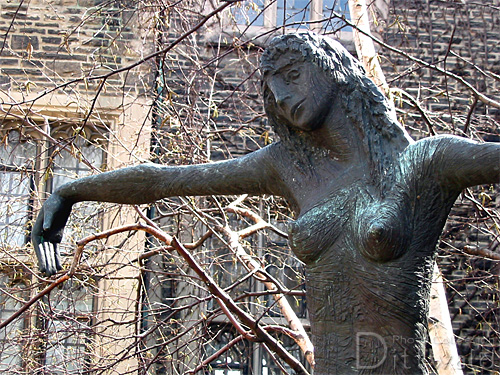Here is my servant, whom I uphold,
my chosen, in whom my soul delights;
I have put my spirit upon him;
he will bring forth justice to the nations.
He will not cry or lift up his voice,
or make it heard in the street;
a bruised reed he will not break,
and a dimly burning wick he will not quench;
he will faithfully bring forth justice.
He will not grow faint or be crushed
until he has established justice in the earth;
and the coastlands wait for his teaching…
…to open the eyes that are blind,
to bring out the prisoners from the dungeon,
from the prison those who sit in darkness.
I am the Lord, that is my name;
my glory I give to no other,
nor my praise to idols.
See, the former things have come to pass,
and new things I now declare;
before they spring forth,
I tell you of them.
Pope Francis, in his first visit to the Holy Land, made an extremely provocative gesture on his way to Bethlehem, by stopping at Israel’s “separation wall”, in particular at a spot that read in graffiti “Bethlehem look like Warsaw ghetto. Free Palestine”, to pray against this symbol of conflict and apartheid. The immense amount of power captured in this gesture, encapsulated many messages from a subtle hint against the US’s recent failed attempts at a peace process, to comparing the suffering of Palestinians to the suffering of those in the Warsaw ghetto, to even implying that the realm of “sensitive politics” was a religious issue.* However, as a good friend, Jared A. Walker** has said, “What happens when an infallible Pope meets an unmovable object…” Indeed, it is the key question to see what happens as a result of this loaded gesture. In fact, it may be instructive to compare this gesture alongside of another instance of symbolic protest, that of the Vodka boycott against Russia’s stance on homosexuality.*** The goal of many bars across North America essentially with this boycott is to protest Russia’s ‘anti-gay’ laws+ that have been enacted recently, as a form of cutting off one of Russia’s main exports in the hopes that the laws will change, though as Robert Joseph Greene notes, the boycott is “mainly symbolic”. Alongside of other forms of symbolic protest such as Pyotr Pavlensky nailing his own scrotum in Moscow’s Red Square, it is thought that drawing attention to what are seen as socially oppressive laws, will not only show the solidarity of the LGBT community around the world, but perhaps even force Vladimir Putin’s hand.
However, as a good friend, Jared A. Walker** has said, “What happens when an infallible Pope meets an unmovable object…” Indeed, it is the key question to see what happens as a result of this loaded gesture. In fact, it may be instructive to compare this gesture alongside of another instance of symbolic protest, that of the Vodka boycott against Russia’s stance on homosexuality.*** The goal of many bars across North America essentially with this boycott is to protest Russia’s ‘anti-gay’ laws+ that have been enacted recently, as a form of cutting off one of Russia’s main exports in the hopes that the laws will change, though as Robert Joseph Greene notes, the boycott is “mainly symbolic”. Alongside of other forms of symbolic protest such as Pyotr Pavlensky nailing his own scrotum in Moscow’s Red Square, it is thought that drawing attention to what are seen as socially oppressive laws, will not only show the solidarity of the LGBT community around the world, but perhaps even force Vladimir Putin’s hand.
The boycott of vodka and Pavlensky’s actions are also loaded symbolic acts that encapsulate messages arranging from the willingness of the LGBT to abstain from a beverage as a way of ‘voting with their dollars’ and identify with the sufferings of those like them around the world, to even denying that sexuality is the key issue in Russian discrimination and instead highlighting that the key issue is the denial of the humanity of those of the LGBT community. In either of these cases, that of Pope’s Francis in Palestine and of bars across North America, there can be no question about their effectiveness as a means of spreadings particular messages against the particular powers that be. What can be questioned however is their effectiveness as a means of protest. In line with a previous essay concerning a return to politically radical theocracy, it may be asked as to how such a perspective can contribute to an understanding of effective protest. Symbolic acts are frequently found throughout the Christian tradition, such as the incident of Jesus’ cleansing of the temple, but an important question to ask in our times of turbulence and social upheavals is what are the elements of an effective protest? Furthermore, if we should find that symbolic acts are not an effective means of protest, then what is the use of symbolic actions? For whom are the messages embedded in the gestures for, if not the powers whom they are against?
The first thing to notice about both Pope Francis’ and the LGBT community’s actions is that neither of them had an major impact.++ As Daniel Levy of the European Council on Foreign Relations has said, the meeting that Pope Francis’ hopes to arrange between the different leaders would “mean nothing in big-picture terms”, and as David Horovitz, editor of the Times of Israel has also pointed out that while psychologically the meeting would be helpful, it would be politically insignificant. In parallel then, it can also be pointed out that Pavlensky’s actions effected no political change, and as Mark Lawrence Schrad has noted, “…the Kremlin’s historic reliance on vodka revenues is largely over…” as many of the companies serving vodka in the United States are made and branded outside of Russia, thus making the boycott effectively futile. If we want to bring this much closer to the Christian tradition, what did Jesus’ cleansing of the temple actually accomplish other than creating a mess, giving his opponents an excuse for his death, and making it look like Jesus’ has an anger problem? In all of these symbolic acts and gestures then we must remember that they are symbolic actions, not concrete actions. One of the great confusions for many in our times is quite clearly not only the substitution for, but the confusion of, symbolic acts and gestures for literal actions. As a result our culture of protest creates various contradictions such as people who protest the destruction of forestry by holding signs made of paper, or protesting capitalism by buying communist memorabilia, or even people who protest religion by going to church. It is these forms of powerfully symbolic but materially ineffective forms of protest that drive us back to our two questions of (i) what makes an effective protest? and (ii) what then is the use of symbolic acts and gesture?
and as Mark Lawrence Schrad has noted, “…the Kremlin’s historic reliance on vodka revenues is largely over…” as many of the companies serving vodka in the United States are made and branded outside of Russia, thus making the boycott effectively futile. If we want to bring this much closer to the Christian tradition, what did Jesus’ cleansing of the temple actually accomplish other than creating a mess, giving his opponents an excuse for his death, and making it look like Jesus’ has an anger problem? In all of these symbolic acts and gestures then we must remember that they are symbolic actions, not concrete actions. One of the great confusions for many in our times is quite clearly not only the substitution for, but the confusion of, symbolic acts and gestures for literal actions. As a result our culture of protest creates various contradictions such as people who protest the destruction of forestry by holding signs made of paper, or protesting capitalism by buying communist memorabilia, or even people who protest religion by going to church. It is these forms of powerfully symbolic but materially ineffective forms of protest that drive us back to our two questions of (i) what makes an effective protest? and (ii) what then is the use of symbolic acts and gesture?
Without much argumentation for sake of brevity, we can note that effective protests protest not only the messages and beliefs embedded in oppressive actions, but that the matrix and means that make these oppressive actions possible. For a simple example, how might one wish to materially and effectively protest abortion if one wished to do so?+++ Often it is thought that one should change the laws to outlaw abortion, or even violently eliminate abortion clinics and doctors to protest abortion materially and effectively. Of the first, however we may question how many fetuses would be rescued by such a procedure, and the answer is not necessarily any because abortion will then be accessed in much more dangerous ways outside of government regulation. The change of the law then would be a ineffective symbolic action meant to express the political change of opinion concerning the morality of abortion, nothing more. What of the second? As for the second, is it not an embodiment of the very ideology they wish to oppose- “You get rid of your problem by killing it”? Neither of these options actually protest the matrix and means that make what they perceive to be a societal evil possible. An effective, non-symbolic, concrete protest against abortion would be inaugurated perhaps by an alleviation of the poverty many women are trapped in that drives them to get an abortion in the first place, or perhaps by massive campaigns at adoptions for the mothers who cannot raise the fetuses they are carrying. Neither of these means of protest are symbolic, nor do they exist within the matrix within which abortion is carried out or participate in the means by which it is carried out. Rather either of these means would be literal actions in protest of abortion because they would not merely send a message against the societal evil, but try effectively to see its decline in society.
Having then given one brief example of what an effective, non-symbolic, concrete protest would be in the face of a societal evil, and left with the project of creating others in the face of other oppressive powers and societal evil~, we are still left then with the question of what then is the use of symbolic acts and gesture? Should symbolic actions like Pope’s Francis’, like the LGBT community’s, like Jesus’ simply be abandoned in favour of further dedication to concrete protest? If then symbolic acts are ineffective as protest, then the potential for them may be found in the messages they carry, as a form of proclamation. The proclamation is a means to send a message not only to the enemy but to the community itself, to remind one another of one’s own mission and formation. Proclamation is not a materially effective form of protest against any power, but it is a wonderful trumpet to announce, “This is who we are and this is what we’re about”, which is as much to warn an enemy as it is to rejuvenate the base. Pope Francis’ action reminded Catholics around the world that the Church is the ministry of reconciliation, the LGBT community’s boycott reminded the community and others that it was not alcohol or sex that defined the problem but the stake of humanity itself, and Jesus’ action in the temple was to remind Israel that the temple was the refuge, not the institution of exploitation.
Protest then is the synonym for alternative action, and proclamation the synonym for symbolic action. One should never confuse creating a piece of art or a symbolic gesture for actual protest, as much as one should never dismiss the need for symbolic action out of zealousness for concrete action, and it is this point on which we shall end. Quite often there is a dismal of philosophy, in parallel with the dismissal of symbolic action or performance art, as a cheap elitist non-sense showing our culture’s lack of ability to address materially and concretely. As Jonathan Jones has said with regard to Milo Moiré’s ‘performance art’ in Germany, where she pushed eggs filled with paint out her vagina in the nude to show the power of the creative feminine, “If performance art did not exist, bile-filled commentators on the modern world would have to invent it. For what else so perfectly captures the cultural inanity of our time?” Perhaps for the example of Moiré we could dismiss it as a piece of art, not for the fact that it is symbolic action however, but for the fact that it is actually a terrible symbolic action in that it embodies the exact opposite of that which it wishes to proclaim, the creative feminine. Symbolic action, for any community of a different social order is necessary, alongside of protest, in order to constantly remind others and itself of its vision of justice against all attempts that would wish to distort it for the community. In religious discourse symbolic action is called ritual, and it is ritual paradoxically that is necessary to keep a community away from the abstract vision of justice as defined by the social order, namely ‘the real, the everyday etc…’ As Slavoj Žižek has rightly written,
“…the highest form of ideology lies not in getting caught up in ideological spectrality, forgetting about its foundations in real people and their relations, but precisely in overlooking this Real of spectrality, and pretending to address directly ‘real people with their real worries’. Visitors to the London Stock Exchange are given a free leaflet which explains to them that the stock market is not about some mysterious fluctuations, but about real people and their products- this is ideology as its purest.” (The Fragile Absolute, 16)
Ritual/Symbolic action, then is necessary for constant reminder of a community’s vision of justice, though it itself does not enact this justice (for this is the job of concrete protest), because visions of justice can be derailed and distorted by other visions constructed by the very ones one wishes to protest against.
At the beginning of this exploration, the prophet Isaiah prophesies that God’s servant while not making loud his voice in the streets like an activist, still “faithfully brings forth justice”. God’s servant will not confuse the bringing forth of justice in concrete protest in the healing of the blind and the freeing of the prisons, with the proclamation of “his teaching”. In perfect harmony with recognition of how to faithfully bring forth justice, is the proclamation and remembrance act as to who defines this vision of justice, which while is a gesture of a non-concrete nature is vitally necessary for the community to remember in their pursuit of this God’s vision of justice, and furthermore to remind the powers which the community is protesting against as to who this community follows exclusively. Thus is the vision of justice in protest and proclamation, word and deed, focused in the politically radical theocratic perspective.
* Many news reports confuse Pope Francis’ statements about his visit to the Holy Land to be “purely religious” to be misleading, while missing the fact that for Pope Francis it was a perfectly accurate statement because the politics of peace and conflict are for him “religious” issues. For such an example: Cole, Juan. “Pope Francis Prays at Apartheid Wall, Calls for Palestinian State.” Alternative news Site. Truthdig, May 26, 2014. http://www.truthdig.com/eartotheground/item/pope_francis_calls_for_palestinian_state_prays_at_apartheid_wall_20140526.
** His work to be accessed here: http://jaredawalker.com/blog/
*** Branson-Potts, Hailey. “Vodka boycott spreads to protest Russian anti-gays laws.” Toronto Star, July 31, 2013, sec. News/World. http://www.thestar.com/news/world/2013/07/31/vodka_boycott_spreads_to_protest_russian_antigay_laws.html.
+ For an interesting examination of which see, Brian M. Heiss’ report, found and summarized helpfully here: https://www.youtube.com/watch?v=btAUWI0rYJg&safe=active
++ Of course the verdict is still out on both of these cases, but in of and themselves, neither of them had huge impact and arguably in all probability, neither of them will lead to any great impact. However f0r an argument that Pope’s Francis’ actions will lead to political change see: Vallely, Paul. “For the First Time, the Holy Land Will Witness a Fearless Pope.” The Guardian, May 22, 2014, sec. Comment is free. http://www.theguardian.com/commentisfree/2014/may/22/pope-francis-holy-land-two-state-palestinians?CMP=EMCNEWEML6619I2.
+++ For another one of Mr. Upton’s essays concerning abortion see:
~ Veganism may be an excellent example of such a protest against the food industry and animal cruelty.

 and he also probably suspected these foreigners of backing the rebels to overthrow him as a challenge to the dominant Global Super power. Well the child escaped to Egypt (ya, cause there’s the place to go if you want peace!), which incidentally is exactly where some of his ancestors were massacred and expelled from, so you can imagine how uncomfortable it was given the ethnic tension. Eventually, once the puppet ruler had died, and his three sons were given separate parts of the kingdom, according to the dictates of the dominant Global Super power…the child returned to his homeland, to hangout in a little nothing ghetto to do the same job his father did. Often he would travel to the ‘big city’, Sepphoris, and get a glimpse of the lives of the wealthy and exotic. Education opportunities were rare, so there was no real way to come up in the world, so he probably just hungout with his family and all the same people he had grown up with for years. In fact, he even had a cousin, John, who was a rowdy political activist with a strange meatless diet, and known for causing trouble for the puppet ruler (calling him out on his terrible marriage ethics).
and he also probably suspected these foreigners of backing the rebels to overthrow him as a challenge to the dominant Global Super power. Well the child escaped to Egypt (ya, cause there’s the place to go if you want peace!), which incidentally is exactly where some of his ancestors were massacred and expelled from, so you can imagine how uncomfortable it was given the ethnic tension. Eventually, once the puppet ruler had died, and his three sons were given separate parts of the kingdom, according to the dictates of the dominant Global Super power…the child returned to his homeland, to hangout in a little nothing ghetto to do the same job his father did. Often he would travel to the ‘big city’, Sepphoris, and get a glimpse of the lives of the wealthy and exotic. Education opportunities were rare, so there was no real way to come up in the world, so he probably just hungout with his family and all the same people he had grown up with for years. In fact, he even had a cousin, John, who was a rowdy political activist with a strange meatless diet, and known for causing trouble for the puppet ruler (calling him out on his terrible marriage ethics).
Recent Comments